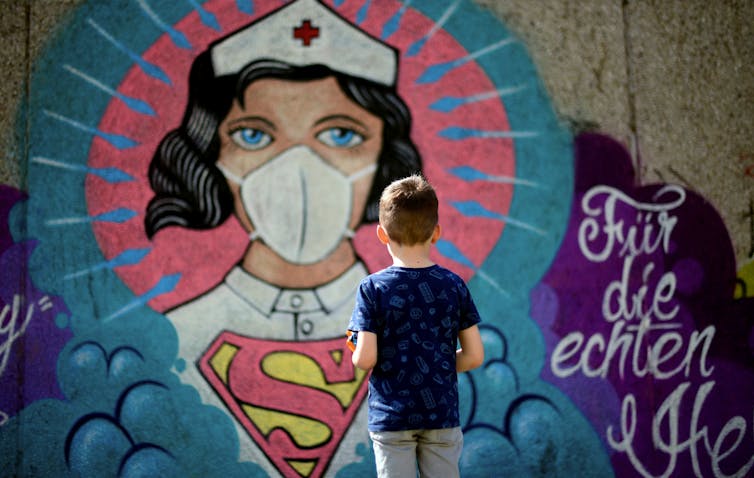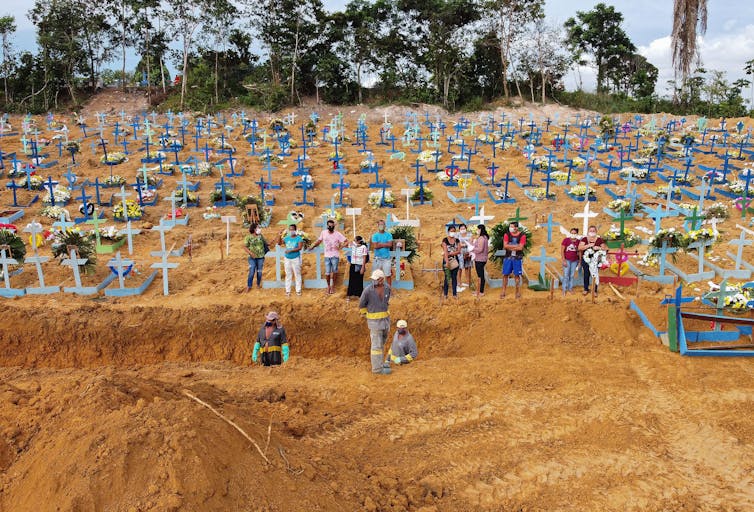How leadership in various countries has affected COVID-19 response effectiveness
- Written by Christine Crudo Blackburn, Deputy Director, Pandemic & Biosecurity Policy Program, Scowcroft Institute of International Affairs, Bush School of Government and Public Service, Texas A&M University
COVID-19 has put political leaders and health care systems worldwide to the test. Although lockdowns are the common approach, some countries have opted for less stringent measures.
As scientists[1] and public policy experts[2], we have spent years analyzing how countries prepare and respond to pandemics. We believe this is certain: The policy and communication choices that national leaders make has a measurable impact on the effectiveness of pandemic response.
Some countries respond with science
In particular, Germany and New Zealand have handled the crisis effectively. Both countries have not wavered from a science-based approach and strong, centralized messaging.
Germany discovered its first cases on Jan. 27[3]. At the time, the country’s health minister considered COVID-19 a low threat; still, Charité University Hospital in Berlin began developing a test. Within a month, new test kits were available – and Germany’s labs had already stocked up[4].
By mid-March, the country had closed schools and retail businesses[5]. Testing was swiftly rolled out, and within approximately two weeks, Germany was processing more than 100,000 tests per week[6]. Around this same time period, the United States had tested approximately 5,000 people[7] and did not reach numbers similar to Germany until several weeks later[8]. Chancellor Angela Merkel led Germany’s coordinated response, which included social distancing policies along with the early and wide-scale testing.
 In Hamm, Germany, a boy stands in front of a graffiti featuring a nurse as Superwoman. Germany is widely credited for its rapid response to COVID-19.
Getty Images / Ina Fassbender[9]
In Hamm, Germany, a boy stands in front of a graffiti featuring a nurse as Superwoman. Germany is widely credited for its rapid response to COVID-19.
Getty Images / Ina Fassbender[9]
Not everything went smoothly. In many instances, lower-level health services[10] still had autonomy; this led to a degree of discontinuity in policy implementation across states. Yet most Germans voluntarily adhered[11] to the policies set forth by the national government. Now Germany is moving to lift restrictions.
New Zealand, led by Prime Minister Jacinda Ardern, responded with a slogan: “We must go hard and we must go early[12].” In mid-February, travelers from China[13] were banned.
On March 23 – a month after its first case – New Zealand committed to a total elimination strategy and implemented a strict national lockdown despite having only 102 COVID-19 cases and no recorded deaths[14]. Schools were closed. So were nonessential businesses. Social gatherings were banned. A 14-day self-isolation period was required for anyone entering the country[15], with a few Pacific Island exceptions.
With a population of just under 5 million, New Zealand has already tested more than 175,000 potentially infected[16] people – approximately 4% of its population. It is now expanding the program.
Like Germany, the country has emphasized science, leadership and consistent messaging. Prime Minister Ardern builds public trust through regular appearances on social media, including posts aimed at children[17]. As of May 9, the country had fewer than 1,500 confirmed cases and 20 deaths[18] from COVID-19.
 A burial takes place at a cemetery in Manaus, Brazil. The grave area hosts suspected and confirmed victims of the pandemic.
Getty Images / Michael Dantas[19]
A burial takes place at a cemetery in Manaus, Brazil. The grave area hosts suspected and confirmed victims of the pandemic.
Getty Images / Michael Dantas[19]
Instead of hand-washing, a hands-off approach
Brazil and Nicaragua have taken a decidedly different approach. Leaders of both countries have adopted a “hands-off” policy – in some cases, even discouraging citizens from following public health measures taken in other countries.
On Feb. 25[20], Brazil recorded its first case. Since then, the country has reported more than 300,000 cases and 20,000 deaths – the third largest outbreak in the world, behind only the U.S. and Russia.
Over these months, President Jair Bolsonaro has said the virus is not a threat, calling it a “little flu[21].” He has also encouraged defiance of[22] social distancing measures put in place by governors.
Brazil has many advantages over its neighbors for an effective pandemic response: universal health coverage[23], a large community-based primary care delivery system, and experience responding to the Zika health crisis in 2015.
But the lack of leadership from Bolsonaro have led some to label him as the “biggest threat[24]” to the country’s ability to fight the SARS-CoV-2. His continued attacks on scientists, universities and experts[25], along with the lack of organized federal response[26], have disrupted efforts to control the pandemic. An Imperial College of London study[27] showed Brazil with the highest rate of transmission of the 48 countries examined.
Nicaragua has also failed to acknowledge the dangers of this virus. President Daniel Ortega, an authoritarian leader who has remained in office despite term limits and sustained popular protests[28] demanding his resignation, is resisting travel restrictions while encouraging schools and businesses[29] to stay open. He discourages the use of masks[30], even by health care workers.
With his wife and vice president, Rosario Murillo, Ortega has suggested that citizens attend church and go to the beach; they even organized a huge parade called “Love Against COVID-19”[31] on March 14. The ruling couple, however, are noticeably absent for many of these activities, at which social distancing is impossible.
In a country of more than 6 million, Nicaragua reported 25 confirmed cases and eight deaths[32] from COVID-19 as of May 15. But many experts suspect the true number of infections is much higher, both because of minimal testing – the government only allows 50 tests per day[33] – and because many COVID-19 deaths are classified as “pneumonia.” Since January 2020, pneumonia deaths in Nicaragua have reportedly been increasing[34]. But there is little government transparency in Nicaragua, so the data is difficult to confirm.
Lessons for the US
Reliance on science and centralized messaging help countries move faster to safely lift restrictions. Confusing and mixed messages, coupled with distrust of scientific experts, lets the virus spread. In the U.S., messaging is confusing and decentralized[35] and defers to state governments for the majority of policy development. This decentralization has led to vastly different actions by governors. Georgia and Texas reopened as cases continued to increase[36], while Washington and Oregon extend lockdowns[37] well into the summer.
A coordinated, science-driven, national-level strategy is vital to an effective response. But at the moment, the U.S. federal government has communicated more like Brazil and Nicaragua, rather than Germany and New Zealand. The examples we highlight here are a warning to all of us.
[Get facts about coronavirus and the latest research. Sign up for The Conversation’s newsletter.[38]]
References
- ^ As scientists (bush.tamu.edu)
- ^ public policy experts (scholar.google.com)
- ^ first cases on Jan. 27 (www.businessinsider.com)
- ^ stocked up (www.nytimes.com)
- ^ closed schools and retail businesses (www.bmj.com)
- ^ 100,000 tests per week (www.ncbi.nlm.nih.gov)
- ^ 5,000 people (www.theatlantic.com)
- ^ several weeks later (ourworldindata.org)
- ^ Getty Images / Ina Fassbender (www.gettyimages.com)
- ^ lower-level health services (www.theguardian.com)
- ^ voluntarily adhered (www.bmj.com)
- ^ We must go hard and we must go early (www.newsroom.co.nz)
- ^ travelers from China (www.reuters.com)
- ^ 102 COVID-19 cases and no recorded deaths (www.thelancet.com)
- ^ anyone entering the country (www.newsroom.co.nz)
- ^ 175,000 potentially infected (www.health.govt.nz)
- ^ aimed at children (www.bbc.com)
- ^ fewer than 1,500 confirmed cases and 20 deaths (www.thelancet.com)
- ^ Getty Images / Michael Dantas (www.gettyimages.com)
- ^ On Feb. 25 (doi.org)
- ^ little flu (www.aljazeera.com)
- ^ encouraged defiance of (www.aljazeera.com)
- ^ universal health coverage (www.medrxiv.org)
- ^ biggest threat (doi.org)
- ^ scientists, universities and experts (theconversation.com)
- ^ lack of organized federal response (theconversation.com)
- ^ study (mrc-ide.github.io)
- ^ authoritarian leader who has remained in office despite term limits and sustained popular protests (theconversation.com)
- ^ encouraging schools and businesses (www.hrw.org)
- ^ use of masks (www.miamiherald.com)
- ^ called “Love Against COVID-19” (confidencial.com.ni)
- ^ 25 confirmed cases and eight deaths (coronavirus.jhu.edu)
- ^ 50 tests per day (confidencial.com.ni)
- ^ increasing (www.reuters.com)
- ^ decentralized (jamanetwork.com)
- ^ Texas reopened as cases continued to increase (www.nytimes.com)
- ^ Oregon extend lockdowns (www.kdrv.com)
- ^ Sign up for The Conversation’s newsletter. (theconversation.com)
Authors: Christine Crudo Blackburn, Deputy Director, Pandemic & Biosecurity Policy Program, Scowcroft Institute of International Affairs, Bush School of Government and Public Service, Texas A&M University

